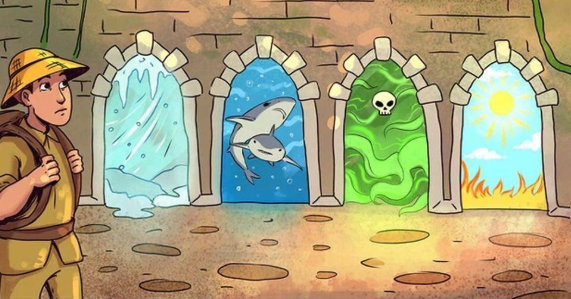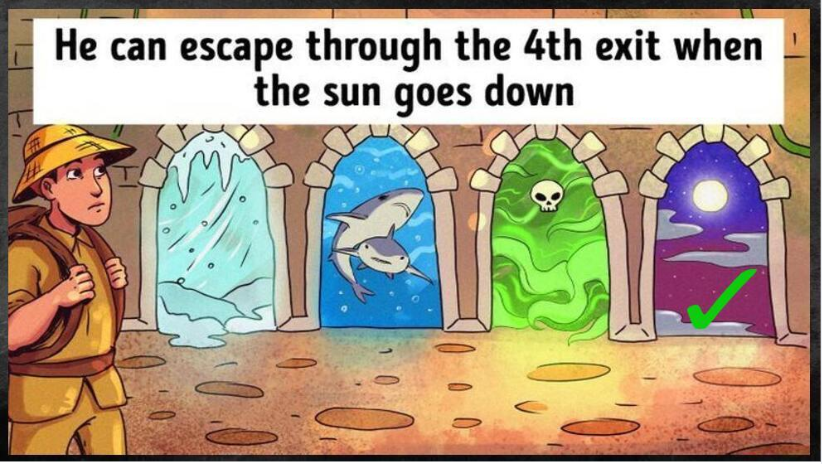Escape Death: Which Door Should You Choose?
Imagine being trapped in a room with four doors, each leading to a potentially fatal scenario. You must choose one door to escape, but the wrong decision could mean certain death. The options include extreme cold, a hungry shark, toxic gas, and intense heat. At first glance, all choices seem equally perilous, but with logical thinking, you can uncover the path to safety. Let’s explore the puzzle step by step.
The Four Dangerous Options
- Door 1: Extremely low temperatures that could freeze you to death.
- Door 2: A hungry shark waiting to attack.
- Door 3: A room filled with toxic gas that could suffocate you.
- Door 4: Intense heat from the sun capable of burning you.

Common Mistakes in High-Stakes Decisions
When faced with high-pressure decisions, it’s natural to act on instinct. Many people make quick choices based on what seems like the most immediate threat, often overlooking critical details. For example, the shark might seem like the most dangerous option at first, but further analysis often reveals a different perspective. The key is to remain calm, evaluate the situation, and think critically before acting.
Analyzing Each Option
Door 1: Extremely Low Temperatures
Freezing temperatures are undeniably dangerous, but death from extreme cold is not instantaneous. The body can survive for a short period in sub-zero conditions, allowing some time to think and act. However, without additional context about the duration of exposure, this door remains a risky but potentially survivable option.
Door 2: A Hungry Shark
Sharks are deadly predators, but they have a critical weakness: they need water to survive. If this door leads to a dry environment, the shark poses no real threat. While unsettling, this scenario may not be as dangerous as it initially appears, as the shark would be unable to attack in a landlocked space.
Door 3: Toxic Gas
Toxic gas is a severe threat, but it doesn’t linger forever in open or poorly sealed spaces. Over time, the gas might dissipate enough to allow escape. Additionally, temporary solutions like covering your nose and mouth with a wet cloth could provide short-term protection. While this door is risky, survival is possible with the right precautions.
Door 4: Intense Heat of the Sun
Heat from the sun can cause severe burns and dehydration, making this option seem lethal. However, the sun sets daily, and with it, the heat diminishes. By waiting for the sunset, the extreme heat becomes a temporary challenge that can be avoided. This insight makes Door 4 the safest choice when timed correctly.
The Correct Answer: Door 4
After evaluating all options, the logical choice is clear: select Door 4 but wait for the sun to set. This solution leverages the natural cycle of day and night, allowing you to escape without harm. Timing is crucial, as the intense heat is only a threat during daylight hours. By waiting, you turn a seemingly deadly situation into a manageable one.

Lessons from the Puzzle
This puzzle highlights the importance of logical reasoning and critical thinking. Acting on instinct alone can lead to poor decisions, especially in high-pressure scenarios. The ability to observe, analyze, and remain calm allows you to identify solutions that might otherwise go unnoticed. These skills are not only useful in puzzles but also in real-life challenges.
Critical Thinking in Action
In situations like these, quick reactions often lead to mistakes. The key is to pause, evaluate all factors, and think strategically. By focusing on overlooked details and maintaining composure, you can find solutions that others might miss. Critical thinking transforms seemingly impossible problems into solvable challenges.
Conclusion
When faced with difficult decisions, fear and panic can cloud your judgment. The best approach is to analyze the situation carefully, consider all options, and act logically. In this puzzle, waiting for the sunset at Door 4 provides a safe escape, demonstrating the value of patience and critical thinking. Apply these principles in your daily life to overcome challenges and make smarter choices.
Share this content:









Post Comment